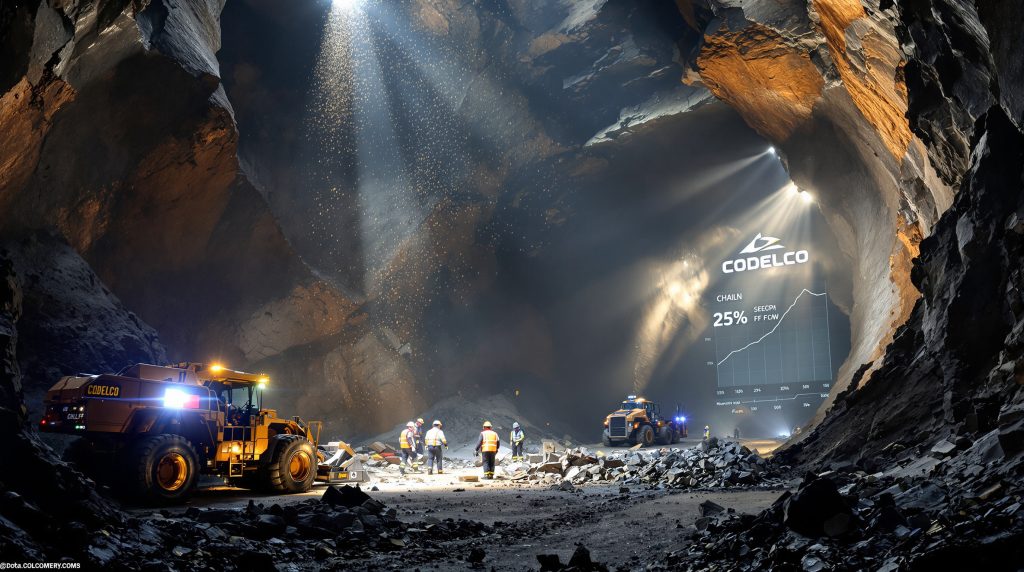Understanding the El Teniente Mine Disaster and Its Aftermath
The Chilean copper industry faced a significant setback when a devastating accident struck Codelco's El Teniente mine on July 31, 2025. This tragic event claimed the lives of six workers and triggered a severe production slowdown at what is widely recognized as the world's largest underground copper mine. The incident not only caused immediate human suffering but also created ripple effects throughout global copper supply markets.
The accident occurred deep within El Teniente's extensive underground network, causing sections of the mine to become inaccessible. Emergency response teams were immediately deployed, but rescue efforts were hampered by unstable ground conditions. Following established safety protocols, Codelco halted all production activities across the operation while rescue attempts and subsequent investigations took place.
According to data from Chilean copper commission Cochilco, the impact on production was severe and immediate. The state-owned mining giant's overall copper output from Codelco slides after mine accident, with total production dropping to just 93,400 tons in August 2025, representing a 25% decrease compared to previous months. Industry analysts estimate the accident reduced annual production by approximately 33,000 metric tons, creating significant challenges for both Codelco and copper markets.
The financial repercussions have been substantial. Industry experts project losses between $300-340 million based on current copper prices and production shortfalls. These figures represent not only the immediate revenue impact but also additional costs related to mine rehabilitation, safety improvements, and potential compensation payments.
The Human Cost and Safety Response
Beyond production statistics lies the more profound human impact. Six families lost loved ones in this tragedy, highlighting the continuing dangers faced by workers in the mining industry despite technological advances. The accident prompted immediate calls for enhanced safety protocols across all Chilean mining operations.
In response to the disaster, mining safety authorities formed an international expert panel to investigate the root causes. While the full findings haven't yet been released, preliminary reports suggest that a combination of factors including geological instability, possible equipment failures, and potential procedural oversights may have contributed to the collapse.
Management changes followed swiftly. According to industry sources, the mine's general manager Andrés Music departed shortly after the incident, with operations manager Claudio Sougarret stepping in to provide interim leadership during this critical period. These personnel changes reflect the gravity of the situation and Codelco's commitment to implementing necessary reforms.
The affected sections of the mine remain closed pending comprehensive safety assessments and infrastructure reinforcement. Mining experts estimate that some areas may require months of rehabilitation work before operations can resume at pre-accident levels. This phased approach prioritizes worker safety while seeking to minimize long-term production impacts.
Codelco's Position in Global Copper Markets
El Teniente holds special significance within Codelco's portfolio as its most profitable mining operation. Prior to the accident, the mine was a cornerstone of Codelco's production strategy, consistently delivering high-grade copper ore that helped offset challenges at other assets. The facility's extensive underground infrastructure represents decades of investment and development.
The timing of this accident was particularly unfortunate for Codelco, which had been experiencing positive momentum in its production efforts. June 2025 data showed a promising 17% year-over-year increase in output, signaling what appeared to be a successful recovery from earlier operational challenges. This upward trend was abruptly interrupted by the July disaster.
El Teniente's contribution to Codelco's overall copper portfolio cannot be overstated. The operation typically accounts for approximately 25-30% of the company's total copper output from Codelco slides after mine accident, making any disruption particularly impactful. The mine's high-grade ore also provides cost advantages that improve Codelco's competitive position against private mining operations.
Codelco had been implementing an ambitious modern mine planning process across its operations, with significant investments targeted for El Teniente. These initiatives focused on extending the mine's productive life through deeper-level developments and technological upgrades. The accident has forced a reassessment of these plans, with resources likely to be redirected toward safety enhancements before expansion efforts resume.
Historical Significance and Future Potential
El Teniente holds remarkable historical significance as a copper mining operation. Active since 1905, it stands as the world's largest known underground copper reserve and has been a consistent producer throughout numerous economic cycles. Its extensive network of tunnels stretches over 3,000 kilometers—enough to connect Santiago with Peru's capital Lima.
The mine operates at elevations ranging from 2,000 to 3,000 meters above sea level in the Andes Mountains. Its high-grade ore body has historically provided Codelco with production cost advantages that strengthen its competitive position in the global market. Even with the current setbacks, El Teniente remains a strategically vital asset in Codelco's long-term planning.
Before the accident, Codelco had been advancing its "New Level Mine" project at El Teniente, aimed at accessing deeper ore reserves that could extend production for several additional decades. This multi-billion dollar initiative represents just one component of Codelco's broader modernization strategy designed to overcome challenges related to aging infrastructure and declining ore grades across its portfolio.
Broader Impact on Chilean Copper Production
Chile's position as the world's largest copper producer makes any significant disruption at major mines a matter of global significance. The El Teniente accident, combined with challenges at other operations, has created notable pressure on the country's overall copper output statistics for 2025.
According to Cochilco data, while Codelco struggled with the aftermath of the El Teniente accident, other major Chilean copper operations showed mixed performance in August 2025. BHP's Escondida mine, the world's largest copper mine, maintained relatively stable production at 105,100 tons. However, Collahuasi—jointly operated by Glencore and Anglo American—experienced a 27% production decline to 35,400 tons, attributed to challenges processing lower-grade ore.
These simultaneous production challenges across multiple major operations have prompted analysts to revise their forecasts for Chile's total copper output in 2025. The combined impact of the El Teniente accident and ore quality issues at other mines could potentially reduce the country's annual production by 2-3%, a significant figure for the world's dominant copper supplier.
Structural Challenges Facing Chilean Mining
The El Teniente incident highlights several structural challenges confronting Chile's copper mining sector. Chief among these is the gradual decline in ore grades across many of the country's major deposits. As mines access deeper sections of ore bodies, they typically encounter material with lower copper content, requiring more processing to yield the same amount of refined metal.
Increasing mining depths create additional technical challenges. Underground operations like El Teniente face greater rock pressure, ventilation requirements, and logistical complexities as they extend deeper into the earth. These factors increase both operational costs and safety risks, requiring more sophisticated engineering solutions.
Water availability represents another critical constraint for Chilean mining operations. Many of the country's major copper deposits are located in arid regions where water is scarce. Mining companies must balance their operational needs against environmental concerns and competition from agricultural and residential users. Water management has become a major focus of investment and innovation across the Chilean mining sector.
The aging infrastructure at many established Chilean mines also presents ongoing challenges. Operations like El Teniente have been active for decades, requiring continuous maintenance and periodic modernization of key systems. The cost of these upgrades represents a significant capital expense that impacts overall profitability.
Recovery and Response Strategies
Following the El Teniente accident, Codelco implemented a comprehensive recovery strategy focusing first on ensuring the safety of remaining operations before gradually resuming production. The immediate response involved evacuation of all personnel from affected areas and establishment of exclusion zones around damaged sections.
Only after thorough safety assessments did Codelco begin limited resumption of operations in unaffected areas of the mine. This cautious approach reflects both regulatory requirements and the company's commitment to preventing further incidents. Four sections of the mine remain closed pending completion of investigations and implementation of necessary structural reinforcements.
The formation of an international expert panel represents a key component of Codelco's response strategy. This independent body brings together mining engineers, geologists, and safety specialists from multiple countries to analyze the accident's causes and recommend preventive measures for the future. Their findings will likely influence safety practices not just at El Teniente but across Codelco's entire operational portfolio.
Management changes followed swiftly after the accident, signaling organizational accountability. The appointment of interim leadership under Claudio Sougarret brought experienced mining management to guide the recovery process. This leadership transition facilitates implementation of new safety protocols and operational adjustments needed to prevent similar incidents.
Recovery Timeline and Implementation
Industry experts estimate that full recovery of production capacity at El Teniente will follow a phased timeline extending over several months. The initial recovery phase focuses on stabilizing affected areas and implementing immediate safety improvements. This is followed by a gradual resumption of operations in sections determined to be structurally sound.
The comprehensive recovery plan includes enhanced monitoring systems for ground stability throughout the underground network. These technologies provide real-time data on structural conditions, allowing for proactive intervention before potential problems develop into dangerous situations. Such systems represent a significant upgrade to traditional visual inspection methods.
Mining methodology adjustments form another critical component of the recovery strategy. Engineers are reassessing extraction sequences and support systems to enhance stability in vulnerable areas. This may include modifications to blasting patterns, increased use of backfill material, and installation of additional ground support elements.
Worker training programs are being enhanced to emphasize hazard recognition and emergency response procedures. This includes regular simulations of potential emergency scenarios and refresher courses on evacuation protocols. The emphasis on preparation and preventive identification of risks aims to create a more resilient safety culture throughout the operation.
Global Market Implications
The production disruption at El Teniente has contributed to tightening global copper supply at a time when demand fundamentals remain strong. This supply constraint comes as copper consumption continues to grow, driven by expanding electrification trends across multiple industries.
Copper prices showed immediate sensitivity to news of the accident. With spot prices already at $5.16 per pound as of early October 2025, the market has absorbed the impact of this supply disruption along with other factors shaping the global copper outlook. The metal's price behavior reflects its critical importance to numerous industrial applications and growing demand from renewable energy and electric vehicle sectors.
The El Teniente disruption represents just one element in a complex global copper supply picture. When combined with Collahuasi's 27% production decline and challenges at other global operations, these disruptions contribute to analysts' projections of a potential copper market deficit in the coming quarters. Such supply-demand imbalances typically support higher price levels unless offset by demand destruction.
Downstream industries dependent on copper inputs are closely monitoring these supply developments. Manufacturers of electrical equipment, construction materials, and transportation components may face challenges securing sufficient copper volumes or managing input cost increases. Some industrial consumers have increased inventory levels as a precautionary measure against further supply constraints.
Strategic Implications for Copper Markets
The El Teniente accident highlights broader supply vulnerabilities in the copper market. With approximately 25-30% of global copper supply potentially affected by various ESG (environmental, social, governance) challenges, the margin for disruption in the market has narrowed considerably. This creates greater price sensitivity to operational issues at major mining operations.
Copper's critical role in the energy transition amplifies the significance of these supply constraints. The metal is essential for renewable energy systems, electric vehicles, and grid infrastructure—all key components of global decarbonization efforts. Analysts project copper demand growth of 3-4% annually through 2030, driven primarily by these green technology applications.
Investment decisions in new copper projects may be influenced by the El Teniente experience. The accident underscores operational risks associated with aging underground mines and may accelerate interest in developing new deposits with more favorable technical characteristics. However, the long lead times for new mine development mean that supply responses cannot occur quickly.
The geographical concentration of copper supply in Chile creates inherent vulnerabilities in the global market. Events like the El Teniente accident demonstrate how regional operational challenges can have global market implications. This reality reinforces interest in developing copper resources in more diverse geographical locations, though Chile's exceptional resource endowment ensures its continued dominance in the sector.
Future Outlook for Codelco and El Teniente
Codelco faces significant challenges in restoring El Teniente to full operational capacity while implementing necessary safety improvements. The most realistic production scenario for the remainder of 2025 involves gradually increasing output as remediation work progresses and closed sections are systematically reopened.
For 2026-2027, medium-term recovery potential depends largely on findings from the ongoing accident investigation and subsequent implementation of recommended changes. If structural issues require extensive redesign of mining methods or infrastructure, the recovery timeline could extend further. However, Codelco's deep technical expertise and substantial resources provide reasonable confidence in eventual restoration of production levels.
The financial resources available for recovery and modernization remain substantial despite operational challenges. As a state-owned enterprise, Codelco benefits from strong government backing and access to capital markets. However, the company must balance recovery investments against other strategic priorities, including development of new projects and modernization of other aging operations.
Comparison with historical recoveries from similar incidents provides some perspective on potential timelines. Previous major operational disruptions at Chilean copper mines have typically required 6-18 months for full recovery, depending on the nature and extent of the underlying issues. El Teniente's recovery will likely fall within this range, with graduated production increases throughout the process.
Lessons for Mining Safety
The technical and operational lessons emerging from the El Teniente accident investigation will likely influence safety practices across the underground mining industry. Preliminary findings suggest increased attention to dynamic ground support systems capable of adapting to changing stress conditions in deep mining environments. Such technologies are becoming increasingly important as operations extend to greater depths.
Industry-wide safety implications extend beyond Codelco to other underground mining operations globally. The accident reinforces the critical importance of real-time monitoring systems, proactive ground control strategies, and comprehensive risk assessment processes. Mining companies worldwide are reviewing their own operations in light of this incident to identify potential vulnerabilities.
Regulatory responses from Chilean authorities may include enhanced inspection requirements and more stringent standards for ground support systems in underground mines. Such measures would align with global trends toward more comprehensive mining safety regulations, particularly for operations in challenging geotechnical environments.
Technological solutions emerging from this experience may accelerate adoption of automation in high-risk mining activities. Remote-operated equipment reduces human exposure in potentially unstable areas, while advanced monitoring technologies provide earlier warning of developing problems. Codelco had already been implementing such technologies as part of its modernization strategy, but this process may now accelerate.
Comparative Analysis of Major Copper Producers
The El Teniente accident has altered the competitive landscape among major copper producers, at least temporarily. While Codelco struggles with reduced output, other global producers have experienced mixed operational results, creating a complex supply picture for the market.
BHP's Escondida operation in Chile demonstrated remarkable stability in August 2025, maintaining output of 105,100 tons despite the challenging conditions affecting other Chilean mines. This performance highlights the operational advantages of Escondida's predominantly open-pit mining methods and relatively young infrastructure compared to El Teniente's underground operation.
Collahuasi's 27% production decline to 35,400 tons resulted from different challenges than those affecting El Teniente. The joint venture between Glencore and Anglo American struggled with lower-grade ore, a common issue as mines progress through their lifecycle. This simultaneous decline from two major Chilean producers amplified the overall impact on market supply.
Freeport-McMoRan reported contrasting performance, with production increasing approximately 3% to 87,500 tons in August 2025. This growth came primarily from the company's Indonesian operations, demonstrating the advantage of geographical diversification in mitigating regional operational risks. The company's positive trajectory contrasts sharply with Codelco's challenges.
Rio Tinto experienced a modest 5% production decline to approximately 62,300 tons during the same period, primarily due to operational adjustments at its Kennecott operation in Utah. While not as severe as Codelco's situation, this reduction further contributed to tightening in the global copper market.
Strategic Shifts Among Major Producers
Investment patterns among major copper producers show increasing preference for brownfield expansion projects over greenfield developments. This strategy leverages existing infrastructure and permitting advantages while minimizing capital requirements and development timelines. However, the El Teniente experience demonstrates that aging operations carry their own significant risks.
Technological adoption rates vary considerably among major producers. Companies like Rio Tinto and BHP have aggressively implemented autonomous and remote operations at many of their sites, reducing human exposure to hazardous conditions. Codelco's modernization program includes similar objectives, though implementation has proceeded at an uneven pace across its portfolio.
ESG performance has become a critical differentiator among copper producers. Companies with stronger environmental management, community relations, and governance practices generally face fewer operational disruptions and enjoy greater stakeholder support. The El Teniente accident demonstrates how safety performance—a key ESG metric—can directly impact production outcomes and financial results.
Merger and acquisition activity in the copper sector has accelerated as companies seek to secure high-quality resources in stable jurisdictions. The challenges facing established producers like Codelco may create opportunities for consolidation as the industry rebalances risk and return considerations. Companies with strong balance sheets are well-positioned to capitalize on strategic acquisition opportunities that may emerge.
| Producer | August 2025 Production | YoY Change | Key Challenges |
|---|---|---|---|
| Codelco | 93,400 tons | -25% | El Teniente accident, aging infrastructure |
| BHP (Escondida) | 105,100 tons | Nearly stable | Water access, labor relations |
| Collahuasi | 35,400 tons | -27% | Lower-grade ore processing |
| Freeport-McMoRan | 87,500 tons | +3% | Positive growth from Indonesian operations |
| Rio Tinto | 62,300 tons | -5% | Operational adjustments at Kennecott |
FAQ: Key Questions About the Codelco Production Decline
Will This Accident Affect Copper Prices?
The El Teniente accident has already contributed to copper price support, with the metal trading at $5.16 per pound in early October 2025, up 1.65% recently. While multiple factors influence copper prices, supply disruptions of this magnitude typically create upward price pressure unless offset by demand weakness.
Market analysts note that copper's supply-demand fundamentals were already tightening before the accident. Global inventory levels at major exchanges have declined steadily throughout 2025, creating limited buffer against production disruptions. The combined impact of El Teniente's problems and challenges at other operations further reduces this cushion.
Historical precedents suggest that major supply disruptions can impact copper price prediction trends for several quarters, particularly when they coincide with strong demand trends. The market's response depends partly on how quickly production can be restored and whether other producers can increase output to compensate for the shortfall.
Given copper's critical role in the energy transition and limited near-term supply growth potential, structural support for prices appears likely to persist. Even before the accident, industry forecasts projected growing supply deficits in coming years as demand from renewable energy and electric vehicle sectors accelerates faster than new mine capacity can be developed.
How Will This Impact Chile's Economy?
Copper remains Chile's most significant export commodity, accounting for approximately 10-12% of GDP and more than 50% of export earnings. The production disruption at El Teniente, combined with challenges at other Chilean mines, creates meaningful headwinds for the country's economic growth and fiscal position.
Tax revenue implications are substantial, as mining royalties and corporate taxes from copper producers represent a significant portion of government income. Reduced production translates directly to lower tax receipts, potentially constraining public spending at a time when economic stimulus might otherwise be desirable.
Employment effects extend beyond direct mining jobs to the extensive supply chain supporting major operations like El Teniente. Each direct mining position typically supports multiple indirect jobs in transportation, maintenance services, equipment manufacturing, and other related sectors. Extended production disruptions could trigger temporary layoffs or reduced work hours throughout this ecosystem.
The Chilean government has responded by forming a mining sector working group to coordinate support measures and monitor recovery progress. These efforts aim to minimize economic damage while ensuring that necessary safety improvements are implemented. The government has also signaled willingness to provide temporary regulatory flexibility to facilitate recovery efforts where appropriate.
What Safety Improvements Could Prevent Similar Accidents?
Advanced monitoring technologies represent a critical component of enhanced safety systems for underground mines. These include distributed fiber optic sensing, microseismic monitoring networks, and automated convergence measurement systems that can detect subtle changes in ground conditions before they develop into hazardous situations. Real-time data from these systems enables proactive intervention.
Predictive analytics integrating multiple data streams offer powerful tools for risk assessment in complex mining environments. Machine learning algorithms can identify patterns indicating potential instability by analyzing combinations of factors that might escape human observation. These systems become more effective over time as they incorporate additional data.
Worker training and safety culture development remain fundamental despite technological advances. Regular emergency response drills, hazard recognition training, and empowerment of workers to stop operations when unsafe conditions are observed create important human safeguards. The most effective safety programs combine technological solutions with strong safety culture fundamentals.
Regulatory framework enhancements may include more stringent requirements for ground support systems, ventilation management, and emergency response capabilities. Updated standards typically incorporate lessons from incidents like the El Teniente accident, creating a continuous improvement cycle in mining safety regulations. International collaboration in developing these standards helps disseminate best practices across the global mining industry.
Chilean Copper Industry Resilience and Adaptation
Despite current challenges, Chile's copper industry has demonstrated remarkable resilience throughout its long history. The sector has repeatedly adapted to changing conditions including natural disasters, political transitions, market volatility, and technological evolution. This adaptive capacity provides confidence that current difficulties will eventually be overcome.
Mining companies operating in Chile have accelerated investment in technological solutions to address structural challenges like declining ore grades and increasing depths. These include advanced ore sorting technologies that can economically process lower-grade material, automated equipment that improves productivity in challenging environments, and digital twins that optimize mine planning and operations.
Water management innovations have become increasingly important as environmental constraints tighten. Companies are implementing desalination plants, advanced water recycling systems, and dry processing technologies to reduce freshwater consumption. These initiatives not only address environmental concerns but also secure operational sustainability in water-scarce regions.
Community engagement approaches have evolved significantly, with companies recognizing that social license to operate represents a critical success factor. Collaborative development programs, transparent communication, and meaningful participation in decision-making processes help build productive relationships with local communities. This social foundation becomes particularly important during crisis situations like the El Teniente accident.
Environmental and Sustainability Considerations
Environmental performance standards continue to rise across the Chilean copper industry, driven by both regulatory requirements and stakeholder expectations. Companies are implementing more comprehensive approaches to tailings management, mine reclamation innovations, biodiversity protection, and emissions reduction. These efforts align with global sustainability trends and help secure market access for Chilean copper.
Energy transition represents both a challenge and opportunity for the sector. While copper producers face pressure to reduce their carbon footprint, the metal itself plays an essential role in renewable energy systems and electrification technologies. This creates a compelling sustainability narrative for responsible copper production.
The circular economy concept has gained traction within the industry, with increased attention to copper recycling, waste minimization, and by-product recovery. These approaches reduce environmental impact while potentially creating new revenue streams. However, growing copper demand means that primary production from mines like El Teniente will remain essential despite recycling advances.
Looking ahead, Chile's copper industry faces both significant challenges and promising opportunities. The El Teniente accident represents a serious setback but also catalyzes important safety improvements that will benefit the entire sector. The fundamental value of Chile's exceptional copper endowment ensures continued investment despite operational difficulties, supporting eventual recovery and renewed growth in copper investment strategies.
Ready to Capitalise on the Next Major Mineral Discovery?
As global copper supply faces significant disruptions and price fluctuations, position yourself to identify emerging opportunities before the market with Discovery Alert's proprietary Discovery IQ model that instantly notifies investors of significant ASX mineral discoveries. Explore why major discoveries can lead to substantial returns by visiting Discovery Alert's dedicated discoveries page and begin your 30-day free trial today.




